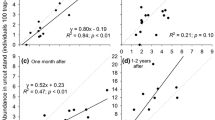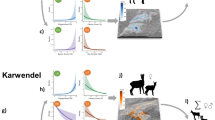Abstract
We questioned the different interpretations of ecological sexual segregation from a novel perspective, i.e., by carrying out diverse temporal and spatial scale analyses within a long-term study (1984–2003). Thus we combined spatial (small/large) and temporal (small/large) scale analyses to identify the factors generating sexual segregation in fallow deer in San Rossore, Italy. The study site was divided into an eastern sector characterized by human disturbance (DS) and a western undisturbed sector (US). According to census data, human presence increased in DS from 1984, and while females gradually abandoned it, males remained—thus supporting the predation risk hypothesis (large spatial and temporal scale)—and actually increased their presence in DS, where they seemingly benefited from a lower female density. This supported the indirect competition hypothesis. The analysis of data on a large temporal and small spatial scale confirmed that intersexual competition, in particular for grass, was higher in a crowded pasture in US. Observations by means of radio-telemetry of 23 adult females and 25 adult males (1997–2001, reduced temporal and large spatial scale) showed that large scale segregation was relevant during the day and disappeared at night, when disturbance was absent and also the females reached DS. This also supported the predation risk hypothesis. Moreover, sexes showed different habitat choices inside DS at night, thus supporting the forage selection hypothesis (small spatial and temporal scale). In conclusion, failure to address the whole set of combinations of spatial and temporal scale analyses would have led to monocausal explanations of ecological sexual segregation.




Similar content being viewed by others
References
Aebischer NJ, Robertson PA (1992) Practical aspects of compositional analysis as applied to pheasant habitat utilization. In: Priede IG, Swift SM (eds) Wildlife telemetry: remote monitoring and tracking of animals. Ellis Horwood, New York, pp 285–293
Aebischer NJ, Robertson PA, Kenward RE (1993) Compositional analysis of habitat use from animal radio-tracking data. Ecology 74:1313–1325
Apollonio M, Focardi S, Toso S, Nacci L (1998) Habitat selection and group formation pattern of fallow deer in a submediterranean environment. Ecography 21:225–234
Apollonio M, Ciuti S, Luccarini S (2005) Long-term influence of human presence on spatial sexual segregation in fallow deer (Dama dama). J Mammal 86:937–946
Barboza PS, Bowyer RT (2000) Sexual segregation in dimorphic deer: a new gastrocentric hypothesis. J Mammal 81:473–489
Barboza PS, Bowyer RT (2001) Seasonality of sexual segregation in dimorphic deer: extending the gastrocentric model. Alces 37:275–292
Bence JR (1995) Analysis of short time series: correcting for autocorrelation. Ecology 76:628–639
Bingham RL, Brennan LA, Ballard BM (2007) Misclassified resource selection: compositional analysis and unused habitat. J Wildl Manage 71:1369–1374
Bleich VC, Bowyer RT, Wehausen JD (1997) Sexual segregation in mountain sheep: resources or predation? Wildl Monogr 134:1–50
Bon R (1998) Perspective éthologique de l’étude de la ségrégation sexuelle chez les ongulés. Habilitation à diriger les recherches. Université Paul Sabatier, Toulouse
Bon R, Campan R (1996) Unexplained sexual segregation in polygamous ungulates: a defense of an ontogenetic approach. Behav Processes 38:131–154
Bon R, Rideau C, Villaret J-C, Joachim J (2001) Segregation is not only a matter of sex in Alpine ibex, Capra ibex ibex. Anim Behav 62:495–504
Bonenfant C, Loe LE, Mysterud A, Langvatn R, Stenseth NC, Gaillard J-M, Klein F (2004) Multiple causes of sexual segregation in European red deer: enlightenments from varying breeding phenology at high and low latitude. Proc R Soc Lond B 271:883–892
Bowyer RT (2004) Sexual segregation in ruminants: definitions, hypotheses, and implications for conservation and management. J Mammal 85:1039–1052
Bowyer RT, Kie J (2004) Effects of foraging activity on sexual segregation in mule deer. J Mammal 85:498–504
Bowyer RT, Kie J, Van Ballenberghe V (1996) Sexual segregation in black-tailed deer: effect of scale. J Wildl Manage 60:10–17
Chapman D, Chapman N (1997) Fallow deer: their history, distribution and biology, 2nd edn. Coch-y-Bonddu books, Machynlleth
Ciuti S, Davini S, Luccarini S, Apollonio M (2004) Could the predation risk hypothesis explain large-scale spatial sexual segregation in fallow deer (Dama dama)? Behav Ecol Sociobiol 56:552–564
Ciuti S, Bongi P, Vassale S, Apollonio M (2006) Influence of fawning on the spatial behaviour and habitat selection of female fallow deer (Dama dama) during late pregnancy and early lactation. J Zool Lond 268:97–107
Clutton-Brock TH, Albon SD, Guinness FE (1987) Sexual segregation and density-related changes in habitat use in male and female red deer (Cervus elaphus). J Zool Lond 211:275–289
Conradt L (1998a) Measuring the degree of sexual segregation in group-living animals. J Anim Ecol 67:217–226
Conradt L (1998b) Could asynchrony in activity between the sexes cause inter-sexual social segregation in ruminants? Proc R Soc Lond B 265:1359–1363
Conradt L (1999) Social segregation is not a consequence of habitat segregation in red deer and feral soay sheep. Anim Behav 57:1151–1157
Conradt L, Clutton-Brock TH, Thomson D (1999) Habitat segregation in ungulates: Are males forced into suboptimal foraging habitats through indirect competition by females? Oecologia 119:367–377
Conradt L, Clutton-Brock TH, Guinnes FE (2000) Sex differences in weather sensitivity can cause habitat segregation: red deer as an example. Anim Behav 59:1049–1060
Conradt L, Gordon IJ, Clutton-Brock TH, Thomson D, Guinness FE (2001) Could the indirect competition hypothesis explain inter-sexual site segregation in red deer (Cervus elaphus L.)? J Zool Lond 254:185–193
Croft D, Morrell L, Wade A, Piyapong C, Ioannou C, Dyer J, Champan B, Wong Y, Krayse J (2006) Predation risk as a driving force for sexual segregation: a cross-population study. Am Nat 167:867–878
Dehn MM (1990) Vigilance for predators: detection and dilution effects. Behav Ecol Sociobiol 26:337–342
Festa-Bianchet M (1991) The social system of bighorn sheep: grouping patterns, kinship and female dominance rank. Anim Behav 42:71–82
Forchhammer MC, Post E, Stenseth NC, Boertmann (2002) Long-term responses in arctic ungulate dynamics to changes in climatic and trophic resources. Popul Ecol 44:113–120
Gaillard J-M, Festa-Bianchet M, Yoccoz NG (1998) Population dynamics of large herbovores: variable recruitment with constant adult survival. Tree 13:58–63
Ginnett TF, Demment MW (1999) Sexual segregation by Masai giraffes at two spatial scales. Afr J Zool 37:93–106
Harris S, Cresswell WJ, Forde PG, Trewhella WJ, Woollard T, Wray S (1990) Home-range analysis using radio-tracking data—a review of problems and techniques particularly as applied to the study of mammals. Mammal Rev 20:97–123
Hebblewhite M (2005) Predation by wolves interacts with the North Pacific Oscillation (NPO) on a western North American elk population. J Anim Ecol 74:226–233
Hofmann RR (1968) Comparisons of the rumen and omasum structure in East African game ruminants in relation to their feeding habits. Symp Zool Soc Lond 21:179–194
Hofmann RR (1973) The ruminant stomach. Stomach structure and feeding habits of East African ruminants. East African Literature Bureau, Nairobi
Hofmann RR, Stewart DRM (1972) Grazer or browser: a classification based on the stomach structure and feeding habits of East African ruminants. Mammalia 36:226–240
Illius AW, Gordon IJ (1987) The allometry of food intake in grazing ruminants. J Anim Ecol 56:989–999
Illius AW, Gordon IJ (1991) Prediction of intake and digestion in ruminants by a model of rumen kinetics integrating animal size and plant characteristics. J Agric Sci 116:145–157
Johnson DH (1980) The comparison of usage and availability measurements for evaluating resource preference. Ecology 61:65–71
Kenward RE, South AB, Walls SS (2003) Ranges 6 v1.2: for the analysis of tracking and location data. Anatrack Ldt, Whareham, UK
Loe LE, Irvine RJ, Bonenfant C, Stien A, Langvatn R, Albon SD, Mysterud A, Stenseth NC (2006) Testing five hypotheses of sexual segregation in an artict ungulate. J Anim Ecol 75:485–496
Machlis L, Dodd PWD, Fentress JC (1985) The pooling fallacy: problems arising when individuals contribute more than one observation to the data set. Z Tierpsychol 68:201–214
Main MB, Weckerly FW, Bleich VC (1996) Sexual segregation in ungulates: new directions for research. J Mammal 77:449–461
Mooring MS, Rominger EM (2004) Reply—is the activity hypothesis the holy grail of sexual segregation? Behaviour 141:521–530
Mooring MS, Fitzpatrick TA, Benjamin JE, Fraser IC, Nishihira TT, Reisig DD, Rominger EM (2003) Sexual segregation in desert bighorn sheep (Ovis canadensis mexicana). Behaviour 140:183–207
Mooring MS, Reisig DD, Osborne ER, Kanallakan AL, Hall BM, Schaad EW, Wiseman DS, Huber RR (2005) Sexual segregation in bison: a test of multiple hypotheses. Behaviour 142:897–927
Morris DW (1987) Ecological scale and habitat use. Ecology 68:362–369
Mysterud A, Stenseth NC, Yoccoz NG, Langvatn R, Steinheim G (2001) Nonlinear effects of large-scale climatic variability on wild and domestic herbivores. Nature 410:1096–1099
Nebel S, Ydenberg R (2005) Differential predator escape performance contributes to a latitudinal sex ratio cline in a migratory shoebird. Behav Ecol Sociobiol 59:44–50
Neuhaus P, Ruckstuhl KE (2004) A critique—can the activity budget hypothesis explain sexual segregation in desert bighorn sheep? Behaviour 141:513–520
Pérez-Barbería FJ, Gordon IJ (2001) Relationships between oral morphology and feeding style in the Ungulata: a phylogenetically controlled evaluation. Proc R Soc Lond B 268:1021–1030
Pérez-Barbería FJ, Robertson E, Gordon IJ (2005) Are social factors sufficient to explain sexual segregation in ungulates? Anim Behav 69:827–834
Prins HHT (1989) Condition changes and choice of social-environment in African buffalo bulls. Behaviour 108:297–324
Prins HHT (1996) Ecology and behaviour of the African buffalo. Social inequality and decision making, 1st edn. Chapman and Hall, London
Rahel FJ (1990) The hierarchical nature of community persistence: a problem of scale. Am Nat 136:328–344
Ruckstuhl KE (1998) Foraging behaviour and sexual segregation in bighorn sheep. Anim Behav 56:99–106
Ruckstuhl KE, Kokko H (2002) Modelling sexual segregation in ungulates: effects of group size, activity budgets and synchrony. Anim Behav 64:909–914
Ruckstuhl KE, Neuhaus P (2000) Sexual segregation in ungulates: a new approach. Behaviour 137:361–377
Ruckstuhl KE, Neuhaus P (2002) Sexual segregation in ungulates: a comparative test of three hypotheses. Biol Rev 77:77–96
Ruckstuhl KE, Neuhaus P (2005) Sexual segregation in vertebrates: ecology of the two sexes. Cambridge University Press, Cambridge
Savin NE, White KJ (1977) The Durbin-Watson test for serial correlation with extreme sample sizes or many regressors. Econometrica 45:1989–1996
Senior P, Butlin R, Altringham J (2005) Sex and segregation in temperate bats. Proc R Soc Lond B 272:2467–2473
Smith PG (2003) Compos Analysis, version 5.1 standard [software]. Smith, Abergavenny UK
Sokal RR, Rohlf FJ (1995) Biometry: the principles and practice of statistics in biological research, 3rd edn. Freedman, New York
Sukumar R, Gadgil M (1988) Male-female differences in foraging on crops by Asian elephants. Anim Behav 36:1233–1235
Villerette N, Helder R, Angibault J-M, Cargnelutti B, Gerard J-F (2006) Sexual segregation in fallow deer: are mixed-sex groups especially unstable because of asynchrony between the sexes? C R Biol 329:551–558
Worton BJ (1989) Kernel method for estimating the utilization distribution in home range studies. Ecology 70:164–168
Yearsley JM, Pérez-Barbería FJ (2005) Does the activity budget hypothesis explain sexual segregation in ungulates? Anim Behav 69:257–267
Young TP, Isbell LA (1991) Sex differences in giraffe feeding ecology: energetic and social constraints. Ethology 87:79–89
Acknowledgements
We are grateful to the “Segretariato della Presidenza della Repubblica”, the Regione Toscana, the Migliarino, San Rossore and Massaciuccoli Regional Park, and the administration of the San Rossore Estate. Special thanks go to A. Zampaglione. We very much appreciated the help offered by all the game keepers of the San Rossore Estate; we also wish to thank R. Gambogi for his assistance in the field work. SC extends a special acknowledgement to S. Grignolio for his ideas and comments during the writing of this manuscript. We thank two anonymous referees for their useful suggestions on the first draft of this manuscript. A. Binelli kindly revised the English version. The authors declare that the procedures used in this work were in accordance with all relevant Italian wildlife and animal welfare legislation.
Author information
Authors and Affiliations
Corresponding author
Additional information
Communicated by: P.B. Banks
Rights and permissions
About this article
Cite this article
Ciuti, S., Apollonio, M. Ecological sexual segregation in fallow deer (Dama dama): a multispatial and multitemporal approach. Behav Ecol Sociobiol 62, 1747–1759 (2008). https://doi.org/10.1007/s00265-008-0603-7
Received:
Revised:
Accepted:
Published:
Issue Date:
DOI: https://doi.org/10.1007/s00265-008-0603-7




